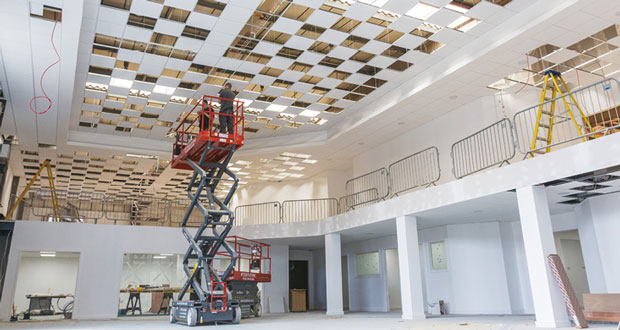 Nigel Harvey, CEO of Recolight, the WEEE compliance scheme for the lighting industry, outlines how FMs can incorporate environmental considerations into lighting
Nigel Harvey, CEO of Recolight, the WEEE compliance scheme for the lighting industry, outlines how FMs can incorporate environmental considerations into lighting
FMs can have a significant impact on the whole life carbon footprint of the lighting they manage. Some of the changes that can be made are relatively simple, whereas others may need the involvement and support of customers.
REPAIR DON’T REPLACE
Where installed fittings are already based on efficient LED technology, a “repair first” strategy is more resource efficient, and has a lower carbon footprint, because the embedded carbon in the light fitting itself is not lost. Clearly not all fittings are repairable, but where this is an option, it should always be the first consideration.
Awareness that replacing old product with new does not usually represent the best outcome for end of life luminaires is much higher. Even when the waste products are recycled, that is still a sub-optimal environmental outcome.
UPGRADE DON’T REPLACE
There are still many large -scale installations of traditionally lamped light fittings. Upgrading those to LED is absolutely correct. The carbon footprint of the use phase of most lighting products is by far the largest part of their whole life carbon footprint, and usually dwarfs the carbon footprint of manufacture and transport. But an even better outcome, is to upgrade any existing fluorescent fittings by simply retrofitting gear trays/light sources. An increasing number of lighting manufacturers are now offering this service.
SPECIFY REMANUFACTURED FITTINGS
A few companies within the lighting industry are starting to offer remanufactured/refurbished light fittings. Such fittings are more resource efficient, and will almost always have a lower carbon footprint than new products. Specifying and selecting remanufactured products will help this sector to grow.
A standard for the remanufacture of luminaires is currently under development – once finalised and published, BS8887 will give specifiers and end users the confidence that remanufactured products can be installed with confidence.
SPECIFY MODULAR LIGHT FITTINGS
Where there are no options for repair, upgrade or remanufactured products, specify modular/repairable fittings. That means that if one critical component fails in use, the component can be replaced without having to replace the complete fitting. This improves resource efficiency and saves the embedded carbon footprint associated with making new products.
TREAT THE OLD FITTINGS WITH CARE
Where fittings are replaced, handle the old fittings with care. If handled correctly, they could be sent for remanufacture, rather than simply recycled. But to be remanufactured, it is vital that they are kept in “as removed” condition.
Where the new fittings are purchased from a Recolight scheme member, then Recolight may be able to direct old fittings to a remanufacturer. For this to be successful, careful removal of the fittings is vital. They should be removed as though they were intended for reinstallation. For example, this means avoiding damage to the housing, placing the fitting on the floor rather than dropping the fitting, and avoiding the use of inappropriate tools.
Any gas discharge lamps should be removed and set aside for collection and recycling.
The fittings should be wrapped appropriately, for example with “cardboard bubble wrap” (which Recolight will supply) to prevent damage, palletised, and shrink wrapped. All fittings should be stored indoors prior to collection by Recolight.
BUY FROM PRODUCERS COMMITTED TO NET ZERO
When specifying new fittings, include a requirement for demonstrable commitments to net zero in the purchasing or tender criteria. Even better, give that requirement a visible and material weighting in the bid assessment process. It is important to check that any such claims are credible so there are a number of ways of checking the reality of the claims:
- Is there visible commitment to the policy from the top of the company?
- Has the company set short-term plans, actions and targets, not just a long-term “Net zero by 20X0” target?
- Check the extent of the target. For example, many companies have a target for 2030, but with a disclaimer that it only covers scope 1 and 2. But for most, the scope 3 use phase is by far the most dominant impact.
- Is the company’s net zero performance regularly assessed by an independent 3rd party?
- Has the company any life cycle assessment data for their products?
- To what extent does the company rely on carbon offsets? Offsets should only cover absolutely unavoidable, irreducible carbon emissions. And even then, they don’t really work. If the company does use offsets, do they have a plan to reduce reliance?
Avoid companies that use the phrase “carbon neutral” – in all likelihood, they will have relied heavily on offsets, rather than changing business practices.
BUY FROM PRODUCERS COMMITTED TO THE CIRCULAR ECONOMY
When specifying new fittings, include demonstrable commitments to the circular economy in the purchasing criteria. Currently, the best way of incorporating this is probably to reference SLL/CIBSE’s TM66 specification. The specification scores a product group against a range of criteria to show the extent to which it embeds circular economy principles. It is currently in beta release, and some of the criteria cannot be reliably and objectively assessed, but it is close. When finalised, TM66 should make it much more straightforward for specifiers to compare the “circularity” of lighting products.





